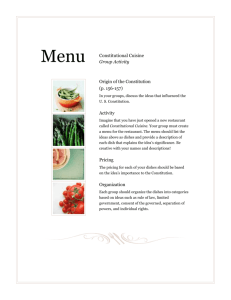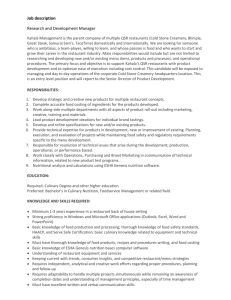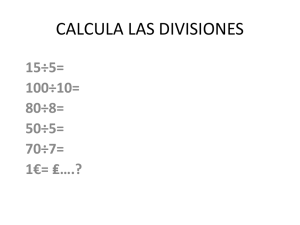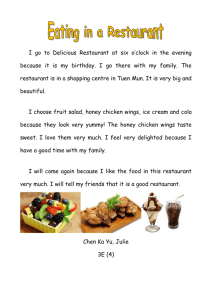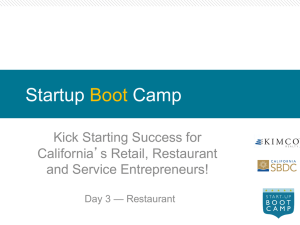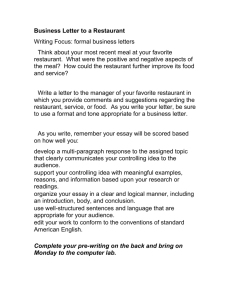Student B: ¡Guácale, que asco! Ugh, how gross!
advertisement
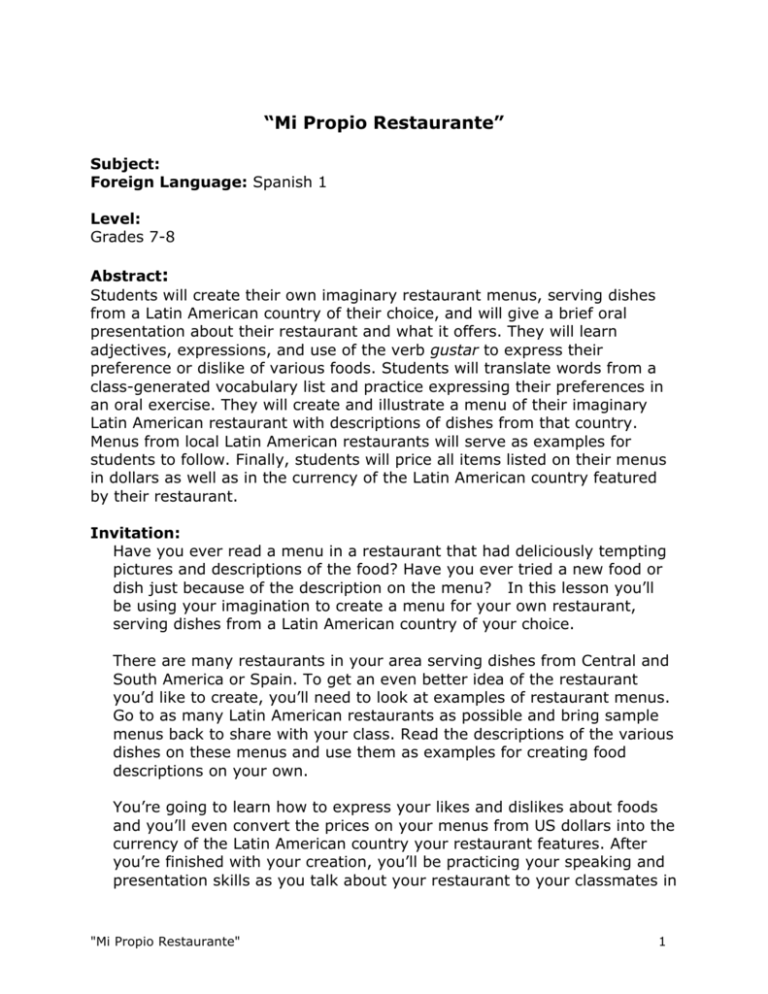
“Mi Propio Restaurante” Subject: Foreign Language: Spanish 1 Level: Grades 7-8 Abstract: Students will create their own imaginary restaurant menus, serving dishes from a Latin American country of their choice, and will give a brief oral presentation about their restaurant and what it offers. They will learn adjectives, expressions, and use of the verb gustar to express their preference or dislike of various foods. Students will translate words from a class-generated vocabulary list and practice expressing their preferences in an oral exercise. They will create and illustrate a menu of their imaginary Latin American restaurant with descriptions of dishes from that country. Menus from local Latin American restaurants will serve as examples for students to follow. Finally, students will price all items listed on their menus in dollars as well as in the currency of the Latin American country featured by their restaurant. Invitation: Have you ever read a menu in a restaurant that had deliciously tempting pictures and descriptions of the food? Have you ever tried a new food or dish just because of the description on the menu? In this lesson you’ll be using your imagination to create a menu for your own restaurant, serving dishes from a Latin American country of your choice. There are many restaurants in your area serving dishes from Central and South America or Spain. To get an even better idea of the restaurant you’d like to create, you’ll need to look at examples of restaurant menus. Go to as many Latin American restaurants as possible and bring sample menus back to share with your class. Read the descriptions of the various dishes on these menus and use them as examples for creating food descriptions on your own. You’re going to learn how to express your likes and dislikes about foods and you’ll even convert the prices on your menus from US dollars into the currency of the Latin American country your restaurant features. After you’re finished with your creation, you’ll be practicing your speaking and presentation skills as you talk about your restaurant to your classmates in "Mi Propio Restaurante" 1 Spanish. You’ll want your restaurant to be very popular, so remember to make your menu as attractive as possible! Be creative and imaginative and don’t forget to have fun. Situations: Where: This lesson could be done in a classroom computer lab setting in a “round robin” style where students may work in small groups or all at once in a computer lab. When: This lesson is ideal for a Spanish 1 class that is studying how to express personal likes and dislikes using the verb gustar, as well as descriptive vocabulary and expressions denoting personal preferences. How Long: This could be a five-to-seven-period lesson depending on the total tasks chosen by the instructor. Tasks: Task 1: In groups of three to four students, a brief brainstorming session will take place during which students will name the categories listed in a typical restaurant menu (appetizers, entrées, etc.) and all of the dishes they can think of (in each category) that are served in the Latin American or Spanish restaurants they’ve gone to. Student groups will name, in English, as many ingredients they can think of in each dish as well as any descriptive vocabulary they can think of that would describe how they felt about a certain food. A vocabulary list is generated from this session. Task 2: Students will either work individually or in small groups as they define words from the class-generated vocabulary list. They will use a Spanish-English dictionary or access an online dictionary web site such as: http://www.spanishdict.com/ in order to define the words from their classgenerated vocabulary list. Task 3: Students will practice using the verb gustar to express their personal likes and dislikes of foods in an oral exercise with their classmates. (See the “Activity: Me Gusta” attachment.) Using a sheet of paper with a 12-square grid, students will write “me gusta” (I like –singular) / “me gustan” (I like –plural) inside the top six squares, leaving a space below to illustrate a favorite food. In the bottom six squares they will write “no me gusta” (I don’t like-singular)/ “no me gustan” (I don’t like-plural) and leave a space to illustrate food items they don’t like. "Mi Propio Restaurante" 2 After their squares are illustrated, students will go about the classroom exchanging information with other student partners about the foods they like or do not like. Encourage students to use reactionary vocabulary by using terms such as “¡Guácale, que asco!” Or “¡Que sabroso!” For example: Student A: Me gustan las papas fritas. Student B: ¡Guácale, que asco! I like French fries. Ugh, how gross! After student partners have exchanged information and responses, they must initial each other’s squares. Students will turn in activity sheet when all 12 squares are initialed. Task 4: Students will start a collection of menus from local Latin American restaurants. Students will go online and search out examples of menus on restaurant web sites; preferably Latin American restaurants, however, this is meant to help students see different ways of displaying and describing dishes. Task 5: After choosing a title for their restaurant and the Latin American country of featured dishes, students will research typical dishes from that country by using the following web sites: http://lanic.utexas.edu/la/region/food/ http://www.txinfinet.com/mader/ecotravel/recipes/recipes.html http://dmoz.org/Home/Cooking/World_Cuisines/Latin_American/ Task 6: Students will create illustrated menus from their imaginary Latin American restaurant. Students must include prices for dishes served that are listed in both dollars as well as the currency of their chosen country. Direct students to the “Menu Rubric” attachment for guidance. See Tip #5. Task 7: After students have determined the US prices on their menu, they will need to convert the price listed in dollars to the currency of the Latin American country their restaurant corresponds to. Students will calculate the conversion of at least one to two items on their menu in class. Have students convert their listed menu prices from dollars to the current exchange rate of their country from the following web sites: http://www.expedia.com/pub/agent.dll?qscr=curc: http://moneycentral.msn.com/investor/market/rates.asp: "Mi Propio Restaurante" 3 Task 8: Students will plan an oral presentation of their menus to the class in Spanish. Students can present their menus using PowerPoint. Direct them to the “Menu Rubric” attachment for guidance as they develop their presentation. Task 9: Have students practice delivering their presentations to a partner or partner group. Students will use the “Menu Rubric” attachment to offer feedback and suggestions for improvement if necessary. Task 10: Student presentations will be delivered as classmates fill out an assessment sheet for each one. Have students fill out an evaluation form for each student presenter. Interactions: Full Class: Students will be introduced to the restaurant and food topic. They will participate in a brainstorming session and student share out. The whole class will create a vocabulary list from student findings to insure all students are working from the same list. The whole class will practice using the vocabulary words with the “me gusta – no me gusta” activity. Partners: Student groups will brainstorm and list typical Latin American or Spanish dishes in several menu categories. Partners or groups may look up vocabulary definitions. Individual: Each individual will copy the vocabulary list and define words. Individuals will create their own “me gusta – no me gusta” activity sheet. They will do research on typical foods from their chosen countries and research online or on-site restaurant menus and share these with the class. Individuals will design their own restaurant menus and convert menu prices from US dollars to the current exchange rate of their Latin American country. They will present their menus to classmates in Spanish. Each student will fill out an evaluation of each presenter and keep track of any information requested by the teacher. Standards: Foreign Language: Spanish Communication: Communicate in languages other than English. 1.1 Students engage in conversations, provide and obtain information, express feelings and emotions, and exchange opinions. "Mi Propio Restaurante" 4 Students present information, concepts, and ideas to an audience of listeners or readers on a variety of concepts. Cultures: Gain knowledge and understanding of other cultures. 2.2 Students demonstrate an understanding of the relationship of the products and perspectives of the culture studied. Connections: Develop insight into the nature of language and culture. 3.1 Students reinforce and further their knowledge of other disciplines through the foreign language. Comparisons: Develop insight into the Nature of Language and Culture. 4.1 Students demonstrate understanding of the nature of language through comparisons of the language studied and their own. Math Standards: 1.0 Students know the properties of and compute with, rational numbers expressed in a variety of forms. 4.0 Students solve simple linear equations and inequalities over the rational numbers. 1.0 Students make decisions about how to approach problems. 2.0 Students use strategies, skills and concepts in finding solutions. Assessment: • “Menu Rubric ” • “Presentation Rubric” Tools: • Microsoft Word • Microsoft PowerPoint Project Tips and Alternatives: Tip #1: You can use an overhead projector to write up a list of categories and their corresponding dishes and ingredients as student groups share their findings. Tip #2: To reinforce vocabulary knowledge, you can create a crossword puzzle using the vocabulary words. See the following web site: http://puzzlemaker.school.discovery.com/ "Mi Propio Restaurante" 5 Tip #3: As an extension to Task 2, students can create illustrated flashcards of the words on their list. They can do this by hand or by using Microsoft Word. With the drawing tool, students can create a grid to use as a guideline for cutting out their cards. They will practice writing their word on the other side of each card. The following clipart web site can be used in addition to the Word Clip Art Gallery to illustrate dishes or food ingredients: http://dgl.microsoft.com/ Tip #4: A quiz on the vocabulary words can be developed online via the following web site: http://www.funbrain.com/ Tip#5: Students can create their menus with Microsoft Word and illustrate them either with student illustrations, magazine images, or Microsoft Word clip art from the following web sites: http://dgl.microsoft.com/ http://www.webplaces.com/search/ http://www.gograph.com/ Tip #6: Here’s a sample student dialog for an oral presentation using the target language: Mi restaurante se llama “La Luna Azul” y sirve comida Venezolana. Los precios son baratos, entre $6.50 y $15.75 por entrada. El plato mas barato es la “ensalada verde a la Venezuela” y el plato mas caro es el “Bifstek a la Parillada.” Le dieron cuatro estrellas en un artículo sobre los restaurantes nuevos de San Jose. Tip #7: During student presentations, the teacher may want to instruct all students to keep track of the restaurant titles or dishes featured and the country they come from and then create a jeopardy game or a “find the restaurant owner…” game for a future class. "Mi Propio Restaurante" 6 Attachments: • “Worksheet: Vocabulary Definitions” • “Template: Vocabulary Flashcard” • “Activity: Me Gusta” • “Menu Rubric” • “Presentation Rubric” • “Presentation Rubric” • “Step Sheet: Typing Spanish Characters in Microsoft Office” • “Step Sheet: Changing the Spelling and Grammar Check” • “Step Sheet: Using a Projection Device” • “Step Sheet: Teacher-Directed Demonstrations” • “Step Sheet: Creating a PowerPoint Presentation” • “Step Sheet: Creating a Slide Show” • “Step Sheet: Creating WordArt” • “Step Sheet: Inserting Pictures into Microsoft Word” • “Step Sheet: Creating Tables in Documents” • “Step Sheet: How To Build a Panel Brochure” Web Resources – Content: A list of linked web resources related to the content of this lesson can be found on the Lesson Page. Web Resources – Word: A list of linked web resources for Word can be found on the Word Resources page. Assistive Technology: Please refer to the Assistive Technology section for information on methods and devices to help ensure that all students have access to the curricula in the least restrictive environment. "Mi Propio Restaurante" 7
